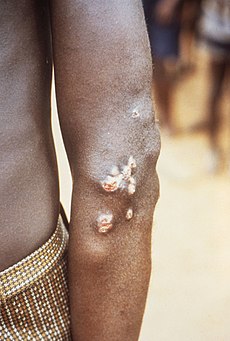Yaws
Yaws is a tropical infection of the skin, bones and joints.[1][2][3] It is caused by the spirochaete bacterium Treponema pallidum pertenue.[4][5]
| Yaws | |
|---|---|
| Classification and external resources | |
 Lumps on the elbow resulting from a Treponema pallidum pertenue bacterial infection | |
| ICD-10 | A66. |
| ICD-9 | 102 |
| MedlinePlus | 001341 |
The disease begins with a round, hard swelling of the skin, two to five centimeters in diameter.[5] The center may break open and form an ulcer.[5] This usually heals after three to six months.[6] After several weeks, or even years later, the joints and bones may become painful, fatigue may develop, and new skin sores may appear.[5] The skin of the palms of the hands and the soles of the feet may become thick and break open.[6] The bones (especially those of the nose) may change shape.[6] After five years or more large areas of skin can die. This leaves large scars.[5]
Yaws is spread by touching the fluid from the sores of a person with the disease.[6] The disease is most common among children, who spread it by playing together.[5]
Other similar diseases are caused by different strains of the same bacterium, such as syphilis (Treponema pallidum pallidum).[6] Once the lesions have appeared doctors are able to tell it is yaws.[6] Polymerase chain reaction (PCR) is the best method of diagnosis.[6]
The main way of stopping the disease spreading, is by curing those who have it. This stops them passing it on to others.[6] Where the disease is common, treating the entire community is effective.[6] Improving cleanliness and sanitation will also decrease spread.[6] Yaws can be treated with antibiotics. Without treatment, physical deformities happen in 10% of cases.[6]
Yaws is common in at least 14 tropical countries as of 2012.[5][6] The disease infects only humans.[6] In the 1950s and 1960s the World Health Organization (WHO) nearly destroyed yaws.[6] Since then the number of cases has increased.
One of the first descriptions of the disease was made in 1679 by Willem Piso. Archaeology shows that yaws may have been present among humans as far back as 1.6 million years ago.[5]
References change
- ↑ It is also known as 'frambesia tropica', 'thymosis', 'polypapilloma tropicum', 'parangi', 'bouba', 'frambösie' and 'pian'.
- ↑ Rapini RP; Bolognia JL; Jorizzo JL. (2007). Dermatology: 2-Volume Set. St. Louis: Mosby. ISBN 978-1-4160-2999-1.
{{cite book}}: CS1 maint: multiple names: authors list (link) - ↑ James W.D.; et al. (2006). Andrews' diseases of the skin: clinical dermatology. Saunders Elsevier. ISBN 0-7216-2921-0. OCLC 62736861.
- ↑ Mitjà O.; et al. (2012). "New treatment schemes for yaws: the path toward eradication" (pdf). Clinical Infectious Diseases. 55 (3): 406–412. doi:10.1093/cid/cis444. PMID 22610931.
- ↑ 5.0 5.1 5.2 5.3 5.4 5.5 5.6 5.7 Mitjà O; Asiedu K; Mabey D (2013). "Yaws". Lancet. 381 (9868): 763–773. doi:10.1016/S0140-6736(12)62130-8. PMID 23415015. S2CID 208791874.
- ↑ 6.00 6.01 6.02 6.03 6.04 6.05 6.06 6.07 6.08 6.09 6.10 6.11 6.12 6.13 "Yaws Fact sheet N°316". World Health Organization. February 2014. Retrieved 27 February 2014.